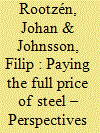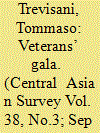|
|
|
Sort Order |
|
|
|
Items / Page
|
|
|
|
|
|
|
| Srl | Item |
| 1 |
ID:
105787


|
|
|
|
|
| Publication |
2011.
|
| Summary/Abstract |
The study evaluates the energy saving potential of the Chinese steel industry by studying its potential future energy efficiency gap. In order to predict the future energy efficiency gap, a multivariate regression model combined with risk analysis is developed to estimate future energy intensity of China's steel industry. It is found that R&D intensity, energy saving investment, labor productivity and industry concentration are all important variables that affect energy intensity. We assess the possible measures as to how China's steel industry can narrow the energy efficiency gap with Japan by means of scenario analysis. Using Japan's current energy efficiency level as baseline, the energy saving potential of China's steel industry is more than 200 million ton coal equivalent in 2008, and it would fall to zero in 2020. However, if greater efforts were made to conserve energy, it would be possible to narrow down the energy efficiency gap between China and Japan by around 2015. Finally, using the results of the scenario analysis, future policy priorities for energy conservation in China's steel industry are assessed in this paper.
|
|
|
|
|
|
|
|
|
|
|
|
|
|
|
|
| 2 |
ID:
149897


|
|
|
|
|
| Summary/Abstract |
This study examines the impacts felt downstream of carbon pricing and investments made in CO2 abatement within the steel industry. Using the supply of steel to a passenger car as a case study, the effects of a steel price increase on cost structures and price at each step of the supply chain were assessed. Since the prices of emission allowances under the European Union Emissions Trading System fall well below those required to unlock investments in low-CO2 production processes in the integrated steelmaking industry this paper seeks to pave the way for a discussion on complementary policy options. The results of the analysis suggest that passing on the compliance costs of the steel industry would have only marginal impacts on costs and prices for the end-use sectors (e.g., on the production cost or selling price of the passenger car). Under the assumptions made herein, at a carbon price of 100 €/tCO2, the retail price of a mid-sized European passenger car would have to be increased by approximately 100–125 €/car (<0.5%) to cover the projected increases in steel production costs.
|
|
|
|
|
|
|
|
|
|
|
|
|
|
|
|
| 3 |
ID:
168832


|
|
|
|
|
| Summary/Abstract |
Since its privatization in 1995, Kazakhstan’s largest steel mill has been in a restructuring process characterized by workforce reduction, augmented pressure on remaining jobs and labour conflict over wages, work conditions and corporate social responsibility. In 2013, in an attempt to re-establish harmonious relationships with workers, management invited the mill’s former labour aristocracy to join a newly established veterans’ council, a forum resembling traditional aksakal councils, to discuss the company’s difficult situation. In the context of a banquet in honour of the veterans, tradition became the contested terrain over which labour and capital struggled to endorse their own visions of the industrial future. As corporate capitalist visions of efficiency and professionalism, ethno-national concerns for harmony and stability, and practices rooted in the Soviet labour legacy clash, tradition is staged by actors as a practice which can either affirm or challenge industrial leadership in a labour conflict.
|
|
|
|
|
|
|
|
|
|
|
|
|
|
|
|
|
|
|
|
|